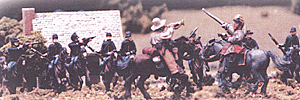 The spring of 1864 brought the titanic campaigns of U.S. Grant and W. T. Sherman upon the Confederacy. While Grant and Meade, commander of the Army of Potomac, battled with Lee and the Army of Northern Virginia to break the stalemate, Sherman relentlessly pushed Johnston and his Army of Tennessee back towards Atlanta.
The spring of 1864 brought the titanic campaigns of U.S. Grant and W. T. Sherman upon the Confederacy. While Grant and Meade, commander of the Army of Potomac, battled with Lee and the Army of Northern Virginia to break the stalemate, Sherman relentlessly pushed Johnston and his Army of Tennessee back towards Atlanta.
Forrest's Men Will Teach Them! 15mm vignette created by John Hill and Doug Kline of Battlefield Terrain Concepts. 22mm Union cavalry by Mucket Miniatures. 28mm Confederate cavalry by The Foundry.
Meanwhile, western Tennessee and northern Mississippi, scenes of great struggles in the previous two years of the war, had lapsed into a back-water. This side theater still held a potential threat to the success of Sherman's advance on Atlanta: Nathan Bedford Forrest.
Sherman's supplies needed to be transported from the depots at Nashville down by rail to his armies in the field. The further Sherman advanced into Georgia, the greater the distance the supplies needed to travel, and so the more vulnerable the rail line became to attack. An expedition in early May, commissioned by Sherman and the Western Tennessee District commander Maj. General Cadwaller Washburn, drove Forrest from Jackson, Tennessee, but failed to destroy him as a standing force. Sherman and Washburn shrugged off Brig. General Sturgis' failure and sent him on a second expedition. This time, Sturgis was to disable the newly-repaired Ohio & Mobile Railroad in eastern Mississippi and therefore negate a possible base for operations on Sherman's flank.
On June 1st, Sturgis' cavalry commander, Benjamin Grierson, began the expedition by leading his horse soldiers east towards Lafayette, Tennessee, in a downpour. Soon the roads were a quagmire, and the infantry division and artillery that followed Grierson on the next day could make little headway in the continuous rain.
The rain cleared on June 5th, which brought a broiling sun to bear upon the column, fatiguing them even more. Sturgis' expedition reached Stubb's Farm, ten miles northwest of Brice's Cross Roads, on June 9th. Brice's Cross Roads lay five miles from Baldwyn and the Ohio & Mobile Railroad. It had one of the few crossings over the swollen Tishomingo Creek.
Forrest had received orders from theater commander S.D. Lee, to stop the Federal expedition before it reached the Black Prairie region of central Mississippi. Given some discretion in his orders, Forrest acted upon intelligence he had received on June 9th that Sturgis was at Stubb's Farm. Forrest sent orders to his nearby commanders to converge on Brice's Cross Roads in a bold if not reckless attempt to deny the water crossing to Sturgis. His plan was to use Johnson's 500 man brigade at Baldwyn to hold off the 3200 troopers of Grierson until the bulk of his force could arrive.
Around 8 A.M. on June 10th, Waring's troopers of Grierson's Division, arrived at the western approach of the bridge over the Tishomingo where they met a detachment from Johnson's Brigade. Waring's men charged the gray horsemen, who gave fire and then quicky rode away toward Baldwyn to inform Forrest of Sturgis' arrival. Grierson quickset Waring in a defensive perimeter to east of the high ground of Brice's Cross Roads while holding his other brigade under Winslow in reserve west of the high ground.
More Brice's Cross Roads July 10, 1864
- Introduction and Historical Background
Scenario
Large Scenario Map (very slow: 249K)
Scenario OOB (slow: 152K)
Back to The Zouave Number 54 Table of Contents
Back to The Zouave List of Issues
Back to Master Magazine List
© Copyright 2001 The American Civil War Society
This article appears in MagWeb (Magazine Web) on the Internet World Wide Web.
Other military history articles and gaming articles are available at http://www.magweb.com